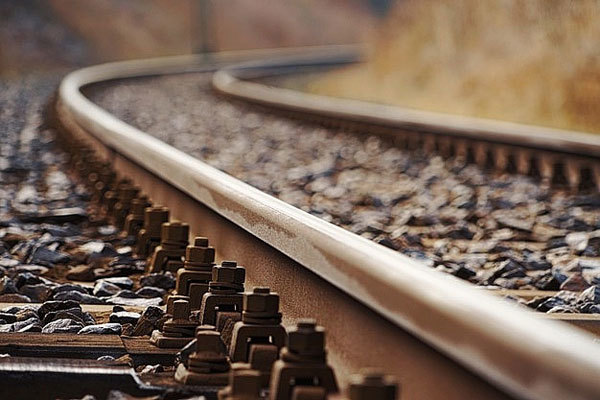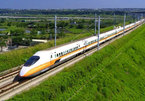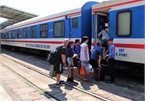 |
The blockage of the Suez Canal last month, the shortest shipping route between Europe and Asia, has once again urged Vietnamese agencies to rethink the pros and cons in development of the railway network to gain bigger future benefits.
Vietnam Railways (VNR) has been awaiting development of the new Lao Cai-Hanoi-Haiphong railway route connecting to Lach Huyen International Gateway Seaport, which helps enhance connection in the East-West Corridor and between Vietnam and China.
VNR deputy director Phan Quoc Anh told VIR, “The project has remained on paper for months. We expect that the study will be fast-tracked so that we can tap into global growing trade. Many regional countries have developed their railway networks, while Vietnam’s remains in standstill.”
Anh and other VNR leaders feel anxious about the current situation, especially when import-export companies in Vietnam and other countries are seeking to diversify their means of transport. Railways are receiving renewed focus following the six-day blockage of the Suez Canal last month by a container ship.
The VNR leader noted, “We are ready to welcome more goods on the Asia-Europe railway route. VNR now accommodates 800,000 tonnes on international connecting trains annually, while our capacity is 2.5 million tonnes.”
However, whether the giant can tap into the advantage remains uncertain as it needs a policy evolution to enable VNR to call for private investment.
Vietnamese railways are still less attractive to importers and exporters, although railway transport times between Vietnam and the EU are quicker and more stable than transport by sea – for instance, the time from Vietnam to Germany is about 29-30 days. Railway transport costs are generally higher than sea transport, driven by unfavourable infrastructure which somewhat partly increases its logistics costs.
The country’s railway network was built over 100 years ago. Dang Dinh Thao, former head of the Institute for Economics and Development Studies, said that the country’s railways have always used diesel technology, while others use electrification or even high-speed electromagnetic trains.
Railways in China and European countries have designed tracks of around 1.43m in width, while that of Vietnam are only one metre. Consequently, importers and exporters have to suffer extra costs of loading and unloading for transit in China. And therefore, few choose railways.
Moreover, a lack of links to seaports, industrial and economic zones is also another problem, preventing the railway sector from attracting customers. The sector now only has one route connecting Hoang Dieu Berth of Haiphong city and the other to Cai Lan Port in the northern province of Quang Ninh.
VNR has been attempting in vain for years to deal with infrastructure weaknesses by calling for private investors to join its upgrading plan and developing warehouses and inland container depots (ICDs). However, legal barriers are as ever impeding the next steps.
As ruled, VNR cannot make any investments or call for funding in the network because of the state asset status. To solve the problem, the giant proposed in a draft master plan in line with Decree No.46/2018/ND-CP issued in 2018 governing the management and use of railway infrastructure assets, for the state to hand over station squares, warehouses, ICDs, and others to it to own, use, and develop with assets to be recorded as state capital contribution to the operator.
The draft, expected to be released in 2019, has yet to be completed. While waiting for this, VNR has been suffering as all investment plans and cooperation with domestic and international private partners have been suspended.
“We earlier signed an agreement with Saigon Newport Corporation to develop ICDs and warehouses at Song Than, Dieu Tri, Yen Vien, Dong Anh, and Dong Dang stations. Some Russian and Kazakhstani companies also sought opportunities in warehouse development in Dong Dang and Lao Cai. All are on paper,” Anh admitted.
Now VNR is facing further disappointment because of the slow pace of drafting the master plan. Vietnam and several countries have consistently planned to develop the Asia-Europe railway route connecting Vietnam, China, Kazakhstan, and Central Asia to Russia and the EU. Years have passed, but true connections have yet to be kicked off and the track size issue among other things have yet to be addressed.
Elsewhere, Laos is tapping into the opportunity of growing trade flows between Asia and Europe by developing the Kunming-Vientiane railway route to connect with the EU.
Currently, all imports and exports from Vietnam to European countries by rail have to transit in China via Lao Cai and Dong Dang railway stations. According to VNR statistics, Vietnam’s railway transport of goods from Vietnam to China and other countries reached nearly 900,000 tonnes in 2020, up about 10 per cent on-year.
In 2021, VNR plans to strengthen transport of cold containers by rail to China and third countries.
VIR

Vietnam speeds up high-speed railway projects
The two high-speed trains are expected to be put into operation by 2030.

Vietnam Railways estimates a $60 million loss due to pandemic
Vietnam Railway Corporation (VNR) estimates a loss of nearly VND1.4 trillion (US$60 million) after tax in 2020, a massive blow to the company due to impacts of the COVID-19 pandemic.